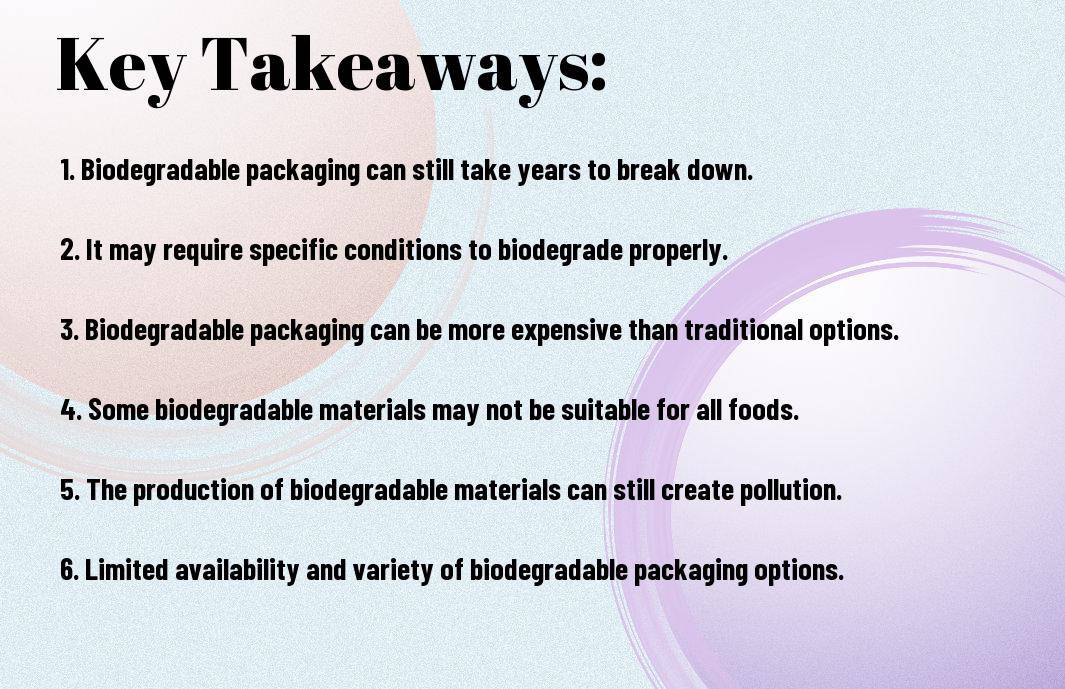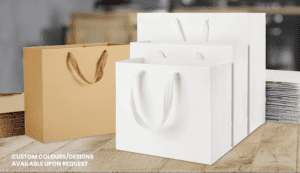Biodegradable packaging has gained popularity as an eco-friendly alternative to traditional plastic packaging for food and drink. But have you ever wondered about the potential drawbacks or limitations of using biodegradable packaging? While it may seem like an ideal solution for reducing our environmental impact, there are some challenges and limitations to consider when using biodegradable packaging for your products. In this blog post, we’ll explore some of these issues and provide you with the information you need to make an informed decision about whether biodegradable packaging is the right choice for your business.
Key Takeaways:
- Variable degradation: Biodegradable packaging may degrade at different rates depending on environmental conditions, such as temperature and moisture, making it difficult to predict how long the packaging will remain intact.
- Limited barrier properties: Some biodegradable materials may not provide the same level of protection as traditional plastic packaging, potentially leading to shorter shelf lives and increased risk of food spoilage.
- Shift in environmental impact: While biodegradable packaging is designed to reduce pollution, the production and disposal of these materials may still have negative environmental implications, such as land use for renewable resources and energy consumption in manufacturing processes.

The Science Behind Biodegradable Packaging
Biodegradable packaging is designed to break down into natural components, such as water, carbon dioxide, and biomass, through the action of microorganisms. The main idea behind biodegradable packaging is that it should not leave any harmful residues in the environment. This is in contrast to traditional plastic packaging, which can take hundreds of years to degrade and can release toxic chemicals in the process.
The Prototypical Design of Biodegradable Packages
Biodegradable packaging is typically made from organic materials, such as plant-based polymers, starches, or cellulose. These materials are chosen for their ability to break down naturally in the environment. The design of biodegradable packages is carefully engineered to ensure that they provide the necessary barrier properties to protect food and drink products while still being able to biodegrade when discarded.
The Degradation Process
Once biodegradable packaging is discarded, it undergoes a degradation process where microorganisms, such as bacteria and fungi, break down the material into simpler compounds. This process is facilitated by environmental factors such as moisture, heat, and oxygen. The end result is the conversion of the packaging material into non-toxic substances that can be safely assimilated back into the environment.
When considering the science behind biodegradable packaging, it is important to understand that not all biodegradable materials are created equal. While some biodegradable packaging may break down quickly and completely, others may leave behind harmful residues or require specific conditions to degrade properly. It is essential to choose packaging materials that have been thoroughly tested and certified as truly biodegradable. Additionally, the degradation process can take varying lengths of time depending on the environmental conditions, and improper disposal of biodegradable packaging can still contribute to pollution. Therefore, it is important to handle and dispose of biodegradable packaging responsibly.
Limitations of Biodegradable Packaging
When considering the use of biodegradable packaging for food and drink, it is important to be aware of its potential drawbacks and limitations. While biodegradable packaging offers numerous environmental benefits, there are certain challenges associated with its use that you need to take into account. In this section, we will explore some of the limitations of biodegradable packaging and how they may impact food and drink products.
Shorter Shelf Life
One limitation of biodegradable packaging is that it may have a shorter shelf life compared to traditional plastic or metal packaging. This is because biodegradable materials are often more susceptible to moisture and oxygen, which can lead to quicker degradation. As a result, the shelf life of products packaged in biodegradable materials may be reduced, potentially leading to increased food wastage. It is important for you to carefully consider the shelf life requirements of your food and drink products before opting for biodegradable packaging, as it may not be suitable for items that need a longer shelf life.
Risk of Contamination
Another potential drawback of biodegradable packaging is the risk of contamination. Biodegradable materials may break down more easily, especially when exposed to moisture and heat. This can create a greater risk of contamination from microorganisms, which could compromise the safety and quality of the packaged food and drink products. It is essential for you to thoroughly assess the potential risk of contamination when using biodegradable packaging, especially for perishable items that are sensitive to environmental conditions.
Additional Drawbacks of using Biodegradable Packaging for Food and Drink
While biodegradable packaging offers several benefits, it also comes with its own set of drawbacks. When considering the use of biodegradable packaging for your food and drink products, it’s important to be aware of these potential limitations.
Environmental Impact
One of the key drawbacks of using biodegradable packaging for food and drink is the potential environmental impact. Some biodegradable materials may still release harmful substances as they break down, contributing to pollution. In addition, the production of biodegradable packaging often requires a significant amount of energy and resources, which can offset the environmental benefits. A study by SwiftPak highlights the environmental impact of both plastic and paper packaging, providing valuable insights into the overall sustainability of biodegradable options.
High Production Cost
Another drawback of biodegradable packaging is the high production cost compared to traditional packaging materials. The manufacturing process of biodegradable materials can be more complex and expensive, leading to higher overall costs for businesses. As a result, you may need to factor in these additional expenses when considering the use of biodegradable packaging for your food and drink products.
Conclusion
Drawing together all the information, it is important to consider the potential drawbacks and limitations of using biodegradable packaging for food and drink. While biodegradable packaging offers numerous environmental benefits, including reduced waste and decreased reliance on non-renewable resources, it also comes with certain challenges. These include the potential for biodegradable packaging to release harmful substances into the environment as it breaks down, as well as the need for specific conditions for effective biodegradation to occur. It is essential to carefully consider these drawbacks when evaluating the suitability of biodegradable packaging for your food and drink products. For more in-depth information on this topic, you can refer to the article Biodegradable Food Packaging: Benefits and Adverse….
Biodegradable Packaging for Food and Drink FAQ
Q: What are the potential drawbacks of using biodegradable packaging for food and drink?
A: Biodegradable packaging may have a shorter shelf life than traditional plastics, which could affect the storage and transport of food and drink products.
Q: Are there limitations to using biodegradable packaging for food and drink?
A: Yes, biodegradable packaging may not be suitable for all types of food and drink products, especially those that require a longer shelf life or specific storage conditions.
Q: Can biodegradable packaging affect the taste or quality of the food and drink it contains?
A: There is a possibility that biodegradable packaging could interact with certain food and drink products, affecting their taste or quality. This is a limitation that needs to be carefully considered.
Q: What about the potential environmental impact of biodegradable packaging production?
A: Although biodegradable packaging is designed to degrade more quickly than traditional plastics, the production process may still have environmental impacts, such as the use of energy and resources for manufacturing.
Q: Are there any challenges in disposing of biodegradable packaging for food and drink?
A: Biodegradable packaging needs to be disposed of properly in order to decompose effectively. There may be challenges in ensuring that it is sent to appropriate composting facilities rather than ending up in landfills.




